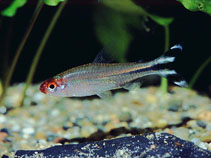| Family: |
Characidae (Characins; tetras), subfamily: Stethaprioninae |
| Max. size: |
3.86 cm SL (male/unsexed) |
| Environment: |
pelagic; freshwater; pH range: 5.5 - 7; dH range: 12 |
| Distribution: |
South America: upper Amazon River basin in Peru; Purus, Negro, and Madeira River basins. |
| Diagnosis: |
This species is distinguished from its congeners by the following characters: maxillary long and wide (vs. very short and round in bleheri and short in rhodostoma); premaxillary teeth in a single row (vs. two in bleheri, rhodostoma); dentary with 9-11 teeth with 5 cuspids (vs. 6, with 6-7 cuspids, followed by 1 or 2 tricuspidate ones in bleheri, and 5-6 with 5 cuspids, usually followed by 4 conical teeth in rhodostoma); black spot on lower posterior border of caudal peduncle absent (vs. present in bleheri, rhodostoma) (Ref. 127081) |
| Biology: |
Feeds on worms, small crustaceans and plant matter (Ref. 7020). Aquarium keeping: in groups of 5 or more individuals; minimum aquarium size 80 cm (Ref. 51539). |
| IUCN Red List Status: |
Least Concern (LC); Date assessed: 04 March 2021 Ref. (130435)
|
| Threat to humans: |
harmless |
Source and more info: www.fishbase.org. For personal, classroom, and other internal use only. Not for publication.

